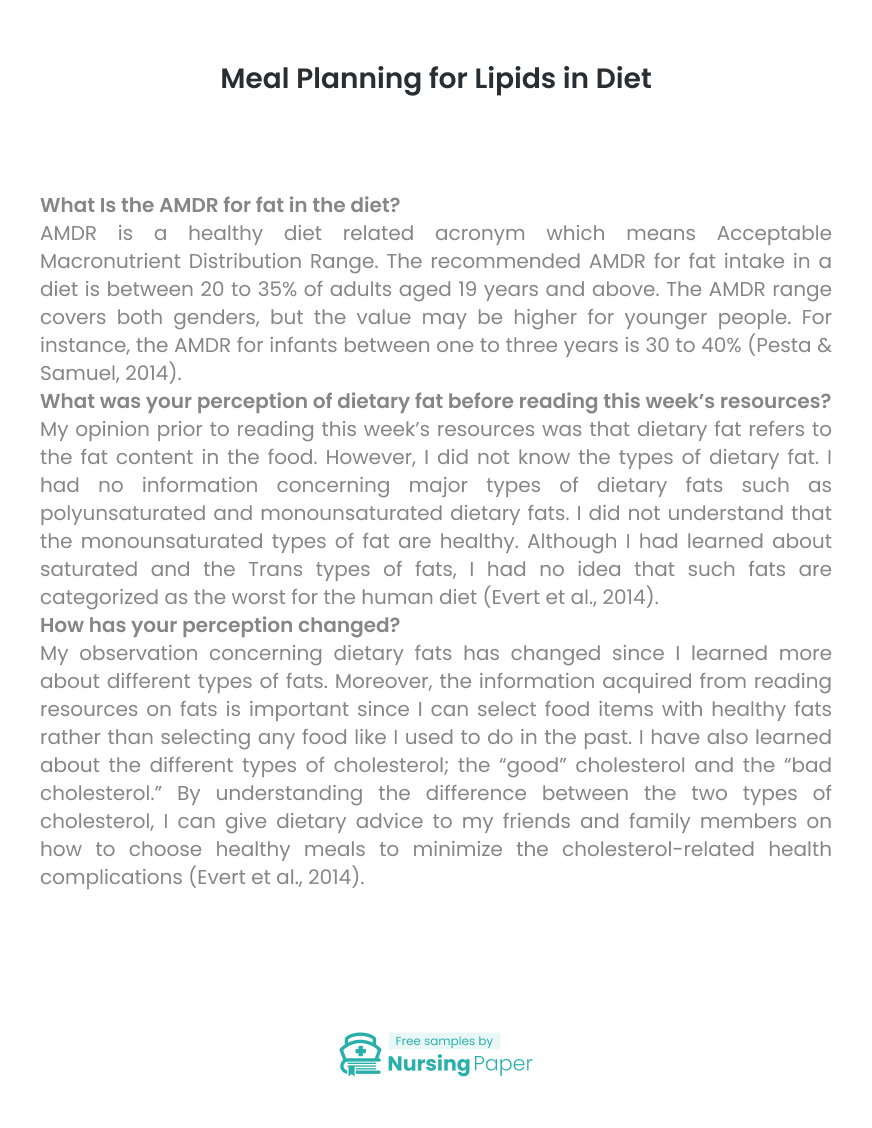
Meal Planning for Lipids in Diet
Interview
What is the AMDR for fat in the diet?
AMDR is a healthy diet related acronym which means Acceptable Macronutrient Distribution Range. The recommended AMDR for fat intake in a diet is between 20 to 35% of adults aged 19 years and above. The AMDR range covers both genders, but the value may be higher for younger people. For instance, the AMDR for infants between one to three years is 30 to 40% (Pesta & Samuel, 2014).


What was your perception of dietary fat before reading this week’s resources?
My opinion prior to reading this week’s resources was that dietary fat refers to the fat content in the food. However, I did not know the types of dietary fat. I had no information concerning major types of dietary fats such as polyunsaturated and monounsaturated dietary fats. I did not understand that the monounsaturated types of fat are healthy. Although I had learned about saturated and the Trans types of fats, I had no idea that such fats are categorized as the worst for the human diet (Evert et al., 2014).
How has your perception changed?

My observation concerning dietary fats has changed since I learned more about different types of fats. Moreover, the information acquired from reading resources on fats is important since I can select food items with healthy fats rather than selecting any food like I used to do in the past. I have also learned about the different types of cholesterol; the “good” cholesterol and the “bad cholesterol.” By understanding the difference between the two types of cholesterol, I can give dietary advice to my friends and family members on how to choose healthy meals to minimize the cholesterol-related health complications (Evert et al., 2014).
Diet
Suggestions for Mrs. Smith’s Diet; decreasing fat and sugar intake
Breakfast
8 oz. whole milk- Replace with skim milk which has a lesser amount of fat at 0.5 oz. Skim milk still has the same amount of calcium, carbohydrates, protein and vitamin D same as whole milk. The advantage is that skim milk has less fat content which is healthy.
8 oz. orange juice
2 fried eggs (fried in butter)
2 slices sourdough toast with 1 tablespoon butter



Snack
1/2 peanut butter and jelly sandwich: 1 slice white bread, 1 tablespoon Skippy peanut butter, 1 tablespoon grape jelly. Replace the white bread with whole wheat bread. Whole wheat bread is prepared with more bran which contributes to the high fiber content, unlike the white bread which is prepared by processed wheat flour with less fiber content.
Lunch
8 oz. cream of tomato soup
1 oz. Potato chips- Remove potato chips from the diet. Potato chips contain more fat and removing it from the diet is does not affect carbohydrate intake since other food will cover it.
1 sandwich: 2 oz. Turkey, 1 oz. salami, 2 slices white bread, 1 tablespoon mayonnaise
8 oz. grape juice
Snack
6 oz. Fruited yogurt, sweetened, whole milk- try eating unsweetened yogurt. Fruited and whole milk yogurts are healthier than the sweetened one which only increases your sugar intake that increases the risk of diabetes.
Dinner
5 oz. dark meat chicken, fried
1 medium baked potato with 1 tablespoon butter, 1 tablespoon sour cream, and 1 tablespoon bacon, chopped
1/2 cup cooked broccoli with 1 tablespoon butter
8 oz. cola- Replace 8 oz. cola with 8 oz water. Cola does not replace the need for hydration in the body. Moreover, it has 30 grams of sugar making it unhealthy.
4 oz. whole milk
Snack
1/2 cup chocolate ice cream
1. Evert, A., Boucher, J., Cypress, M., Dunbar, S., Franz, M., Mayer-Davis, E. & Yancy, W. (2014). Nutrition therapy recommendations for the management of adults with diabetes. Diabetes Care, 37, 1, S120-S143.
2. Pesta, D., & Samuel, V. (2014). A high-protein diet for reducing body fat: mechanisms and possible caveats. Nutrition & metabolism, Biomed Central Journal 11, 1, 53



The download will start shortly.

The download will start shortly.
 Subject:
Medicine
Subject:
Medicine  Number of pages: 6
Number of pages: 6  Subject:
Nursing
Subject:
Nursing  Number of pages: 4
Number of pages: 4  Subject:
Health and Social Care
Subject:
Health and Social Care  Number of pages: 2
Number of pages: 2  Subject:
Medicine
Subject:
Medicine  Number of pages: 16
Number of pages: 16  Subject:
Health and Social Care
Subject:
Health and Social Care  Number of pages: 5
Number of pages: 5  Subject:
Medicine
Subject:
Medicine  Number of pages: 3
Number of pages: 3  Subject:
Medicine
Subject:
Medicine  Number of pages: 2
Number of pages: 2  Subject:
Medicine
Subject:
Medicine  Number of pages: 3
Number of pages: 3  Subject:
Health and Social Care
Subject:
Health and Social Care  Number of pages: 3
Number of pages: 3  Subject:
Nursing
Subject:
Nursing  Number of pages: 4
Number of pages: 4  Subject:
Nursing
Subject:
Nursing  Number of pages: 2
Number of pages: 2  Subject:
Health and Social Care
Subject:
Health and Social Care  Number of pages: 2
Number of pages: 2  Subject:
Health and Social Care
Subject:
Health and Social Care  Number of pages: 3
Number of pages: 3  Subject:
Medicine
Subject:
Medicine  Number of pages: 4
Number of pages: 4  Subject:
Health and Social Care
Subject:
Health and Social Care  Number of pages: 3
Number of pages: 3 
